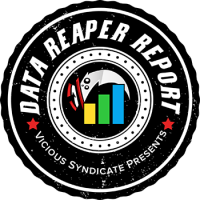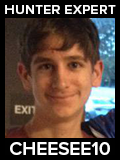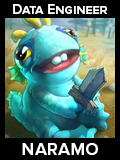
Welcome to the 171st edition of the Data Reaper Report!
Contributing to the Data Reaper project through Hearthstone Deck Tracker or Firestone allows us to perform our analyses and to issue the weekly reports, so we want to wholeheartedly thank our contributors. Without the community’s contributions, there would be no project. Contributing data is very easy, so if you enjoy our content and would like to make sure it remains consistent and free – Sign up!
Quick Links
Class/Archetype Distribution | Class Frequency | Matchup Winrates | vS Power Rankings | vS Meta Score | Class Analysis & Decklists | Meta Breaker of the Week | How to Contribute | Credits
Number of Games
| Overall | 250,000 |
| Top 1K Legend | 8,000 |
| Legend (Excluding Top 1k) | 58,000 |
| Diamond 4 to 1 | 48,000 |
| Diamond 10 to 5 | 50,000 |
| Platinum | 33,000 |
| Bronze/Silver/Gold | 53,000 |
Class/Archetype Distribution
[TABS_PRO id=42116]
Class Frequency
[TABS_PRO id=42117]
Class Frequency Discussion
The Scholomance Academy meta in the aftermath of the balance changes is quite diverse. Throughout most of ladder, you can observe 6 or 7 classes displaying very similar play rates. Diversity can also be found within classes and archetypes, so the meta seems to be at a great starting point.
One class that seems to stand taller above the rest is Rogue. It has been the most influential class in the post-patch meta, and it was headed in this direction regardless of the balance changes last week. It is the most popular class at Diamond and above, thanks to the success of Aggro Rogue. This archetype is split into two variants (Stealth Hyper vs Stealth Dancer), but there is a significant overlap between them. Miracle Rogue has a much smaller representation but is fairly popular at top legend.
Guardian Druid is attempting to adjust to the nerf to Kael’thas, and it is currently transitioning away from the Survival build to the Malygos build. This internal shift is particularly prevalent at higher levels of play, where Druid’s play rate is only second to Rogue’s.
Though Priest is quite common throughout ladder and exhibits two ‘established’ archetypes, it might be the most chaotic class in Scholomance Academy. Both Highlander and Galakrond Priest have been thrown into an experimental frenzy in response to the drastic meta shifts following the first week of the expansion, and neither archetype has been solidified in its build. Highlander Priest was refined early on in the expansion but is now revisiting its previous choices. In contrast, Galakrond Priest was never figured out and still looks miles away from stabilizing.
Warrior has had a complete facelift from the early days of SA. Bomb Warrior is now the most dominant deck within the class, while Big Warrior has severely shrunk in size and other Warrior decks have disappeared. Bomb Warrior is split between Ancharrr builds and Galakrond builds (there’s a small subset that runs both), with the latter looking significantly more popular.
Demon Hunter has also changed. Soul Demon Hunter (previously known as Control Demon Hunter) has surged in its play rate, and is all the rage at top legend where it is heavily experimented with. Aggro Demon Hunter is common throughout ladder, but takes a backseat at higher levels of play to the newly emerging archetype.
Mage is a relatively experimental class that is finding its feet. Cyclone Mage is the most popular deck, and increases in popularity at higher levels due to its success against Aggro Rogue. Highlander Mage is around but fades away as you climb the ranks. Fireworks Mage is disappearing, to the surprise of no one considering its horrendous win rate. A few players have embraced Turtle Mage, the reincarnation of Shudderwock Shaman, but the deck still sits in meme status.
Pure Paladin is extremely popular on the climb to legend, but drastically declines at legend. Its play rate is incredibly low at top legend after much talk of the deck being exposed by the rise in efficiency of other classes as well as the rise of counter decks such as Miracle Rogue and Cyclone Mage.
Hunter is steadily rising in popularity while internally changing. Face Hunter has now taken priority as the premier archetype over Highlander Hunter, with promising results in its performance against Aggro Rogue. The deck is still deep in the refinement phase as it attempts to sort out the final few cards in its build.
Warlock is in decline, as players have abandoned its slower archetypes in the face of an increasingly aggressive meta. Only Zoo Warlock is noticeably common, with its Masochist build taking shape.
Shaman is at the bottom of the meta, without a single deck gaining significant traction on ladder. Quest Shaman sits at the frontier of experimentation at higher levels, and we’ll have to see whether it can produce the results required to salvage what seems to be a doomed class.
[TABS_PRO id=42118]

[TABS_PRO id=42119]
vS Meta Score
[TABS_PRO id=42120]
vS Power Rankings Discussion
Scholomance Academy could become one of the most competitive metas we’ve had in Hearthstone, and we guarantee plenty of twists and turns in its story. While it’s been three weeks since the launch of the expansion, it’s important to understand why certain archetypes perform the way they do, and whether they can improve beyond what their current win rate suggests.
- Rogue:
- Aggro Rogue looks firmly established at Tier 1. When accounting for its popularity and resulting Meta Score, it’s certainly the most influential deck in the format at higher levels of play. Are we witnessing the emergence of a meta tyrant? We don’t think we are, since we can identify several decks that can significantly improve their performance against it with some smart card choices (P.S Ooze is not a smart card choice). Aggro Rogue is powerful, and both of its variants are successful, but we think there’s a good chance that the meta will find an effective response in the next couple of weeks that keeps its win rate reasonable.
- Miracle Rogue looks competitive, but its rise in win rate was halted by the rise of Bomb Warrior and the increased efficiency of Aggro Rogue. The archetype’s potential is quite high considering that most ladder players continue to run the Vendetta build with Dragon’s Hoard and Cult Neophyte. These cards are a huge liability and we think an optimal Miracle Rogue build can do much better than that.
- Galakrond Rogue is just too slow. The current meta is extremely burn-centric: there are popular aggressive decks with a lot of direct damage, in addition to popular weapon decks that smack you in the face. This kind of field is extremely hostile to a slow-paced deck that takes a long time to find its power plays and has no significant life gain mechanics.
- Druid:
- We can tell you with a high degree of confidence that the Malygos variant of Guardian Druid is better than the Survival variant in the aftermath of the Kael’thas nerf. This transition is helping keep Guardian Druid at the top half of the table, and we think it might be able to do more than that. Malygos Druid is back and its potential is high.
- Priest:
- After we labeled it as a Meta Breaker in the first week of Scholomance Academy, Priest’s win rate has completely collapsed in incredible fashion. Was this caused by the nerf to Illucia? No, this change hardly made an impact. The main cause of Priest’s decline lies in its removal kit. At the beginning of Scholomance, Priest found success by running a lot of high impact removal to counter Survival Druids and Pure Paladins. The current meta is obviously very different, and cards that previously helped Priest find success are much weaker today (for example, Headmaster Kel’thuzad and Shadow Word: Ruin).
- Players didn’t adjust, and kept playing the same lists they netdecked before, but these builds are poorly positioned to deal with the meta we see today. Other players were baited by narrow tech choices to respond to drastic meta shifts, but these tech choices are not effective against a very diverse meta. Adjustments are required, and these adjustments can very possibly change Priest’s current ladder fortunes.
- An optimized Highlander Priest is, at worst, a Tier 2 ladder deck at all levels of play, and it should be easy to refine in order to improve its Rogue matchup by a few crucial percentage points. Highlander decks are generally not difficult to fix.
- More work is required on Galakrond Priest, which is littered by terribly tuned lists that have sunk its win rate to the dumpster. We believe that an optimized Galakrond Priest is too good to sit in the dumpster, and we’ve already identified the way it gets out of it. We will see how high it can get then.
- Warrior:
- A day before the patch last week, Bomb Warrior looked like the best deck in the game and exhibited an extremely dominant win rate. It was essentially last week’s meta breaking deck, but the field has aggressively responded to it since. The rise of Rogue and Hunter, as well as a flood of weapon tech dropped it to Tier 2. It looks strongest at top legend due to the small number of Paladins at these ranks.
- Big Warrior has fallen hard. The deck is struggling to deal with the rise in efficiency of several aggressive decks that give it no time to breathe, while Priest represents a very difficult matchup thanks to Cabal Acolyte.
- Demon Hunter
- Soul Demon Hunter has great potential to be a top tier deck. Its matchup spread looks incredible but is blemished by three red squares: Guardian Druid, Pure Paladin, Bomb Warrior. If it can increase the consistency of its game plan by finding its damage (and its lifesteal weapon), as well as the consistency of its Blade Dance combos to deal with Druid/Paladin boards, we could have a game-changer in our hands.
- Aggro Demon Hunter has dropped Glide, and the result is a significant rise in its win rate, kissing Tier 1 at some rank brackets. The archetype is pretty solid and well-rounded, with few unfavorables. Its biggest issue is facing Soul Demon Hunter.
- Mage
- Cyclone Mage is one deck that we saw carrying massive potential, and we wouldn’t have been surprised to see it hit Tier 1. What prevented that from happening is the rise of Bomb Warrior and Soul Demon Hunter. Cyclone Mage doesn’t appreciate being smacked in the face by these decks, as it has a much better time contesting the board. It’s very effective at beating Aggro Rogue for that reason, but has an issue when it faces a deck that carries most of its damage off the board.
- Highlander Mage faces similar struggles against these decks, but doesn’t have the good Aggro Rogue matchup to offset them. In addition, it is crippled by Hunters, leading to an underwhelming performance against the field. It just didn’t possess the scope for improvement at the beginning of the expansion that other decks had.
- Is this it for Mage? It might not be. Within the Turtle Mage meme, an archetype that displays an atrociously poor win rate, we found a build that could actually be competitive. We estimate that if everyone just netdecked Americas Grandmaster Eddie, Turtle Mage would be as strong as a Tier 2 deck in the current meta! Who knows, it could even be better than that. Yes, Turtle Mage is real.
- Paladin
- There is a misconception about Paladin amongst the player base. It is a dominant deck on the climb to legend, and its performance declines at higher levels of play. But, its performance at higher levels of play is still very good! Pure Paladin is simply very well positioned to counter current meta trends. It’s still an effective counter to Guardian Druid, but it also counters both Bomb Warrior and Soul Demon Hunter, while providing ample resistance to Aggro Rogues and Hunters. Its poor matchups aren’t prevalent enough to cripple its win rate, even though they are more popular at top legend (Miracle Rogue, Cyclone Mage). Don’t sleep on Paladin: we expect its win rate to decline to some degree due to its low scope for improvement in its build, but it should continue to do well against some of the best decks in the format. It’s a great ladder choice.
- Hunter
- Hunter is probably the most slept on class in the format. Face Hunter looks like the strongest deck in the game at Diamond 4 and above. It is the best counter to Aggro Rogue, and its build could be improved to counter Rogue even harder (with Explosive Trap). In addition, it performs exceptionally well against Bomb Warrior since most of them no longer run Skipper/Armorsmith (and even if they do, you’ll be shocked to hear that Face Hunter is STILL favored). It doesn’t even lose to Druid or Priest at the moment, with its only bad matchup being the lifestealing Soul Demon Hunter (the matchup against Aggro DH can also be improved through Explosive Trap). To conclude, Face Hunter looks like this week’s Meta Breaker, and it’s not even a close call.
- With Face Hunter getting so much attention, you’d think that Highlander Hunter was now bad, but it really isn’t. It has a well-rounded matchup spread but happens to falter to the dominant aggressive deck of the format, which isn’t different from its story throughout Ashes of Outland: Decent, but not spectacular, until Demon Hunter was nerfed for the 5th time.
- Warlock
- Zoo Warlock has two major problems. The first is that it struggles against the hottest classes of the meta (Demon Hunter, Hunter, Rogue, Warrior). The second is that someone decided that running Desk Imp and Felosophy was a good idea. A Tier 5 build has spread within the Zoo archetype to cripple its aggregated win rate. Once it fades away, things should look better for Zoo, but as long as the meta looks the way it is, it will struggle to be better than average.
- Slower Warlock archetypes are being ruthlessly burnt down by the burn meta. Galakrond Control Warlock is the only deck that looks remotely playable and could perform better if it finds a way to consistently activate its Nether Breath, but even then, this meta is quite hostile to the life tapping class.
- Shaman
- We think Shaman looks hopeless. Now, you might look at Totem Shaman’s performance and say it’s quite decent. Its win rate is even positive at lower ranks. However, its win rate is slipping downwards and the deck has no room to grow. Our experience tells us it will continue to decline in its win rate until it disappears, or remain a permanent feature of Bronze ranks, like Resurrect Priest.
- And then you’ve got decks like Quest and Highlander Shaman, that have such bad scores, they basically fall off the charts. Could Shaman find its own Turtle Mage? It’s possible, but we don’t think Shaman has quite a good enough shell for it. *Badum tish*
Class Analysis & Decklists
Demon Hunter | Druid | Hunter | Mage | Paladin | Priest | Rogue | Shaman | Warlock | Warrior
Rogue has established itself as one of the strongest classes in the game, with Aggro Rogue looking very dominant, backed up by two variants of slightly different styles.
The Hyper Aggro build performs better in the mirror and against Druids, Paladins, and Warlocks. It is also less vulnerable to weapon tech. We’ve swapped out Cold Blood and the 2nd Sap for Hooked Scimitar and Akama. Scimitar provides a more efficient source of damage than Cold Blood, while Akama provides more consistency on turn 3. Sap has gotten weaker over the past week due to the decline in Paladins and Druids, and the latter’s transition into the Malygos variant which normally doesn’t run Ironbark. We will note that we were quite close to cutting Backstab (!) from the deck, but estimated that running both Cold Blood and Hooked Scimitar without Backstab would create some clunkiness. Backstab is generally not a great card in this deck, and you shouldn’t keep it in the mulligan unless you’re facing a deck with multiple 1-drops (Demon Hunter, Hunter).
The Dancer Aggro build is stronger against Warriors, Priests, and Cyclone Mages. Other than swapping the 2nd Sap for the 2nd Delinquent, we haven’t made any changes to the build. We haven’t identified any other cards that could improve this variant, though players continue to experiment and may still find a hidden gem.
Miracle Rogue is also fairly successful, though it runs into an issue in the mirror against Aggro Rogue and has also struggled to deal with the rise of Bomb Warrior. We reiterate that Dragon’s Hoard and Cult Neophyte, which are present in the common yet vastly inferior ladder build, are very weak cards in the deck. We’ve replaced Lilian and Plagiarize (our weakest secret) for Spymistress. The deck is starved of turn 1 plays, especially in aggressive matchups, and we have a strong indication that Spymistress will be a very good addition.
Druid is looking to bounce back from the nerf to Kael’thas by transitioning into the Malygos Guardian build. This variant was largely inferior to the Survival variant before the patch, but is now significantly stronger and could eventually completely take over the archetype.
The Standard Malygos Guardian Druid is unchanged from before the patch. It performs well against Bomb Warrior, Priests and Mages. An alternative build was proposed by Orange, which runs Crystal Power and Anubisath Defenders over Nature Studies and Bogbeams. These changes are geared to improve aggressive matchups, with a specific focus on Aggro Rogue. Since we’re running Anubisath Defenders, we include two Overflows and cut Jepetto Joybuzz. Jepetto is excellent against slower decks, so these adjustments do drop some percentages in Malygos Druid’s stronger matchups.
Survival Guardian Druid did have some developments before the patch involving Animated Broomstick, which looks like a great card in the deck. Not only does it have synergy with Survival of the Fittest, but it makes Lake Thresher a better card, and a pretty lethal combo. As a result, we run two Lake Threshers and one Teacher’s Pet. Crystal Power is the card to make way for Broomstick, and we insist on running Anubisath Defender over Wild Growth.
The meta has significantly changed, which forces Priest to retool its removal kit towards countering the new decks at the top of the meta. From the big and beefy Druids and Paladins, we now have to deal with the sneaky Rogues.
This means Highlander Priest should cut its heavy removal. Cards such as Shadow Word: Ruin and Time Rip are very slow in the current meta. Meanwhile, both Wild Pyromancer and Wretched Tutor offer us a way to clear a board of stealth minions, and can be game-winning in every aggressive matchup when utilized with Apotheosis. Wandmaker and Draconic Studies are good enablers for them, while Animated Broomstick is another flexible form of removal.
The most novel and thought-provoking change in the featured build involves cutting Dragonqueen Alexstrasza! Alexstrasza is dramatically underperforming, and spends far too much time rotting in your hand and generally not contributing to the deck’s win condition (in most scenarios in which you get to play her, you’re already winning). We would like to see whether her absence is actually felt.
Galakrond Priest must also adjust, and current ladder builds are ill-equipped to combat new threats. The Pyromancer/Wandmaker package carries a lot of promise against the rising threats. Fate Weavers are fairly weak when we don’t run at least four invokes, and both Time Rip and Shield of Galakrond are a bit too heavy against the current field. You want cheap and flexible cards.
Bomb Warrior has exploded into the scene, and immediately attracted the attention of a meta that was very quick to tech against it. But, even with all the Oozes running around, Bomb Warrior is one of the stronger decks in the format. This is mostly true at higher levels of play, where Paladin isn’t as common.
The most popular variant of Bomb Warrior is the Galakrond build, which runs Kronx and no invokes. Galakrond is used as a finisher, providing you with repetitive damage to wear down opponents who have already become vulnerable to your bombs. This build looks superior to the Pirate build, as even though it is worse against aggressive decks (since we’re not running Skipper/Armorsmith), it is dramatically better in slower matchups.
A card that isn’t commonly played but looks like a surefire winner in the deck is EVIL Quartermaster, repeating its success from Ashes of Outland. There is room to make two small adjustments in the deck. Running two Hoard Pillagers over two Upgrades helps you against Oozes, but is generally weaker unless you run into a lot of them. Running two Whirlwinds over two Brawls can be massive against Aggro Rogues, but hurts your slower matchups (Druid, Mage, Paladin).
Big Warrior has fallen hard in its play rate and win rate, as a result of hostile meta shifts as well as its low scope for improvement. The deck has serious problems facing Rogues and Priests, making its position in the meta precarious. Other Warrior decks haven’t gained any traction following the patch.
Demon Hunter may have finally diversified into two distinct, but very successful playstyles. While Aggro Demon Hunter has long solidified its position in the meta, Soul Demon Hunter is exhibiting massive potential.
The breakthrough in Soul Demon Hunter came from Ike’s build, which added Battlefiend and Glaivebound Adept. Battlefiend is the Mana Wyrm of the deck, offering cheap damage and board presence in the early game. Glaivebound Adept has already proven to be a perfect fit for Marrowslicer in Aggro DH, and provides more damage to Soul DH to finish games off.
But current Soul DH builds run two legendary cards that are not pulling their weight in the deck. Lorekeeper Polkelt feels good to play at times, but is largely a liability in most matchups. There are too many scenarios in which you cannot afford to re-order your deck and start the Skull chain, making it a dead draw. It’s particularly bad in fast matchups, and when you do find the right time to play it, you were already in a winning position without it.
Magtheridon is the second “trap” card. It is strong against Paladin and Druid, but is pretty horrendous against other classes (especially Warrior, Priest and Rogue). Furthermore, it is becoming less important against Druids as they transition into the Malygos build. Without Survival of the Fittest, your best card in the matchup is Blade Dance, which is more than enough to deal with their Guardian Animals turn. Use Blade Dance well, and you won’t miss Magtheridon in the matchups he’s felt needed in.
To replace them, we run Spectral Sight. Adding card draw increases the deck’s all-around consistency. It finds you the damage you need to finish games, making Polkelt less of a crutch, but it also helps you find healing through Soul Fragments. You just never run out of steam.
Mage looks mediocre at the moment, though the class does have some room for growth, and there’s an intriguing development within an archetype that looked like a certified meme just a week ago.
Cyclone Mage’s greatest strength in the current meta lies in its Aggro Rogue matchup, as it is one of its biggest counters. The archetype has solidified its build. We like the multiple win conditions available to the deck through Chenvaala and Ras Frostwhisper. Violet Spellwing is too good, so we’re back to running two copies of it. Firebrand is also invaluable in its early game board control. Arcane Intellect is a bit redundant alongside Cram Sessions, so running one copy looks correct, while Conjurer’s Calling is a luxury card the deck can’t afford in most matchups.
Highlander Mage doesn’t seem to have much room for improvement, and the deck has been hit hard by the rise of several burn decks that expose its lack of life gain. Bomb Warrior and Soul Demon Hunter are hard-hitting decks that give it a lot of problems, while Druid’s transition into Malygos is not doing Mage any favors either.
Turtle Mage looked complete garbage since its inception, but a treasure has finally been found among the trash, and that is Eddie’s Grandmaster list. With Firebrand and Imprisoned Observer, the deck’s ability to stall the game to turn 8 significantly rises. Wandmaker and Wand Thief are flexible, cheap cards that provide fuel for Firebrand. Sunreaver Warmage is a better version of Nightblade, while Jandice offers a board centric win condition that synergizes with our ability to repetitively freeze the opponent’s board. She looks essential.
We’ve made two tweaks to the deck. Bone Wraith is one of the deck’s best cards, so we’ve added the second copy of it. Earthen Ring Farseer is only strong post-Pilgrim, so we’ve reduced it to one copy instead. It is likely that Cult Neophyte is stronger than Acidic Swamp Ooze, but we’re not completely sure about it, so we leave it as a flexible slot that you can experiment with.
The current meta is all about burn, which doesn’t suit a class that’s currently centered on suiciding into payoffs. Warlock is struggling to climb to the high tiers of the meta due to the success of Rogue, Warrior, Demon Hunter, and Hunter in establishing burn-centric game plans.
Zoo Warlock has fully embraced the masochistic path, and the only change we suggest to its current build is cutting one Vulture for the 2nd Scholar. The deck is very strong against classes that give it time to develop its game plan, like Paladin, Druid, and Priest. However, it is usually not able to impose itself on the opponent with its Flesh Giants against the aforementioned burn classes.
Galakrond Warlock is the only slow Warlock deck that looks remotely competitive, but its survivability issues represent all archetypes of the class. The dragon package now looks far too important to omit, as the Artificer/Nether Breath combo is one of your strongest tools to win your worst matchups.
The issue is Nether Breath’s consistency. With only 3 dragons in the deck, our on-demand healing is not actually very on-demand. Our novel suggestion is to run Evasive Wyrm. It fills the curve at 6 mana and has an immediate impact on the board, which means it has a chance to be serviceable. The card to make way for Wyrm is Tour Guide, which may sound like a crazy idea, but Tour Guide isn’t as strong in a deck that doesn’t run Flesh Giants.
Hunter is the sleeper class of the format, exhibiting two very successful archetypes, and one of them is arguably meta breaking in its power level.
Face Hunter is the only deck in the format that counters Aggro Rogue while also beating Bomb Warrior in impressive fashion. With the format dramatically changing over the last couple of weeks, an internal change within Face Hunter could also be in store. Explosive Trap is the best secret if you want to annihilate Rogues, making it very difficult for them to race you. The alternative is running Pressure Plate or Freezing Trap, which is more suitable to combat Druids and Paladins. Toxic Reinforcement could also make its return, as it synergizes well with Explosive Traps and helps you close games in slower matchups.
But the real novelty in Face Hunter could come from Lorekeeper Polkelt. The card puts your finishers at the top of your deck: Dragonbane, Eaglehorn Bow, and Kill Command. Early impressions suggest it could become core to the deck, so try it out.
Highlander Hunter hasn’t seen many changes. We’ve opted to drop Siamat for Kill Command in order to give the deck more reach and racing potential, while ensuring that Dinotamer Brann is the first card you draw after playing Polkelt.
Paladin continues to impress, and has seen some favorable meta changes with the rise of Bomb Warrior and Soul Demon Hunter. The burn-centric meta lines up well into Paladin’s game plan since it’s allowed to develop a board and recover through Libram of Hope.
We continue to recommend the Pure Paladin build we’ve settled on before the patch, as it is well-rounded and allows us to perform well in a variety of matchups. The option is there, however, to punish burn decks even further by running Amber Watchers over Argent Braggarts. With Face Hunter likely to rise in popularity, and Aggro Rogue, Demon Hunter, and Bomb Warrior continuing to succeed, it might be a viable path.
Shaman has looked fairly disappointing. Quest Shaman looks nowhere near competitive, with a horrendously poor matchup spread. Highlander Shaman is an even bigger meme, while decks like Spell-Damage and Galakrond Shaman have long faded out of the scene.
The only Shaman deck that looks remotely competitive is Totem Shaman, but it is very polarizing and easily exposed. Its performance at higher levels of play is in decline, where it is not even considered a serious option. As time goes on, we suspect that it will only get worse.
Aggro Rogue looks like a dominant aggressive deck, but one of its weaknesses in the current meta is dealing with Face Hunter. The historically infamous deck is capable of outracing the Rogue for lethal while crippling its ability to mount an assault due to Explosive Trap.
In addition, Face Hunter is surprisingly effective against the slower decks in the meta, as they are not currently built to outlast the amount of damage it can dish out. Voracious Reader makes sure you don’t run out of damage, while Lorekeeper Polkelt puts your main finishers on top of your deck, ready to end the game.
Face Hunter is certain to shake up the Power Rankings, and it should also provide competition to Priest in the BM Rankings.
Meta Breaking, in more than one way.
Preparing our weekly article requires a significant amount of time and effort from many individuals. We would like to wholeheartedly thank our current Patreons, whose generous donations help us fund computing and server costs.
vS Gold is a new membership plan aimed to support our efforts towards improving our content and data analysis while receiving some bonuses and extra features.
Tier 3+ Patrons
Special thanks to Leo G, Aaron B, Jed M, Drew M, Alan J, Zolstar, Sean H, Steve F, Andrew N, NObdy, Alonso P, James Y, Je-ho, Ziqiao Y, Stephen H, William H, Patrick L, 1RiceBowl1, Alex S, PeejTreon, Josh G, Sam, James C, Matthew H, Bruno B, Amir, and Matthew P for supporting us this month.
Contributors
Here are all the people that participated in bringing you this edition of the vS Data Reaper Report:
































Great report as always!
The only difference with my Face Hunter list, which performed well for me in tournaments and took me to 1000 Legend, is one Pack Tactics instead of Polkelt. I’ll give Polkelt a try but I like keeping a third secret in there in tournaments (open decklists) to keep the opponent guessing. I’m not sold on Pack Tactics however.
I think it’s about time you changed you meta breaker image to add Demon Hunter, which pretty much was the meta for much of the last 5 months!
Also, it would be nice if you could look at how your ads interact with mobile devices. The page jumps up and down all the time and refreshes quite often, going back to the top. This makes it completely unreadable except by loading it in one go and then going into airplane mode, but this of course prevents any of the links from working.